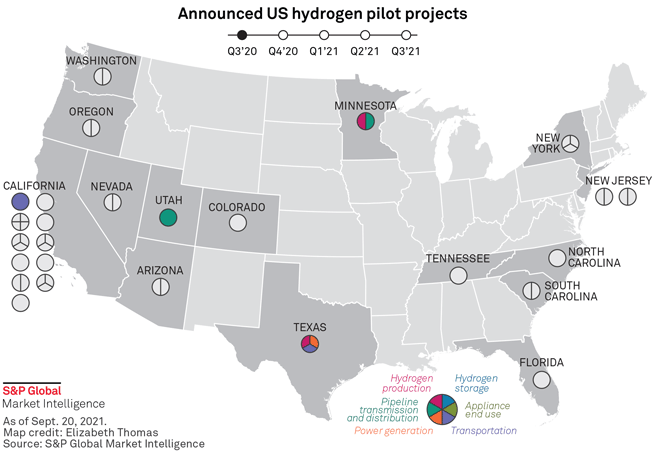Featured Topics
Featured Products
Events
S&P Global Offerings
Featured Topics
Featured Products
Events
S&P Global Offerings
Featured Topics
Featured Products
Events
S&P Global Offerings
Featured Topics
Featured Products
Events
Financial and Market intelligence
Fundamental & Alternative Datasets
Banking & Capital Markets
Economy & Finance
Energy Transition & Sustainability
Technology & Innovation
Podcasts & Newsletters
Financial and Market intelligence
Fundamental & Alternative Datasets
Banking & Capital Markets
Economy & Finance
Energy Transition & Sustainability
Technology & Innovation
Podcasts & Newsletters
9 Sep, 2022
California natural gas utilities have proposed a series of hydrogen blending pilot projects in working distribution systems that will be geared toward the development of pipeline injection standards.
Sempra subsidiaries Southern California Gas Co. and San Diego Gas & Electric Co. each put forward demonstration projects to blend hydrogen into gas distribution systems on college campuses in a Sept. 8 filing with the California Public Utilities Commission, or CPUC. Southwest Gas Corp. proposed a pilot project that will deliver a hydrogen-natural gas blend to commercial customers in Truckee, Calif.
The utilities are seeking CPUC approval to carry out the pilots and create balancing accounts to track and ultimately recover their costs. The demonstration projects would be the first among dozens proposed by gas utilities to attempt to blend low-carbon hydrogen at high concentrations — up to 20% of pipeline volumes — in U.S. distribution systems serving customers.

"The intent really is to also work with the academics to design the experiments and to get that data as quickly as possible, because we know there is a real hunger to understand what standards the state should be looking at for injection," SoCalGas Vice President for Clean Energy Innovations Neil Navin said in an interview.
The CPUC has explored hydrogen injection standards at least since November 2019, when the commission issued a new phase of its biomethane rulemaking to address renewable hydrogen transport in gas pipelines. In 2021, the CPUC rejected a hydrogen blending demonstration proposed by the three utilities and Pacific Gas and Electric Co. but offered guidance on submitting a future proposal.
Demonstration projects to provide data
The new proposal followed a University of California at Riverside study, conducted to help the CPUC establish standards and interconnection protocols that would govern hydrogen injection into the state's gas pipelines. The report recommended real-world blending demonstrations to address outstanding questions regarding hydrogen's impact on system integrity and end-use equipment at volumes greater than 5% of the gas stream.
The utilities intended to begin blending hydrogen at 5% by volume or less in the live systems, gradually increasing the concentration to 20%. The projects would gather data on "pipeline integrity and compatibility with blend concentrations, fluctuations in gas composition and concentrations, leakage (if any), [and] effects on metering, safety, and end-user appliances to ensure appliances functioned correctly and without modifications," according to the filing.
The pilots could provide enough data to develop interim injection standards, particularly for low-concentration blends, the utilities said.
"To the extent that we can demonstrate that we can safely deploy these lower percentages, there may be fewer standards that actually need to be developed," Navin said. "But as you go to these higher percentages, that is when you're looking at a process of consensus-building among people who build standards."
The SoCalGas pilot would focus on blending hydrogen produced through electrolysis into a medium-pressure system with mixed steel and plastic pipes on the University of California at Irvine Campus. SDG&E would conduct its blending demonstration in a medium-pressure system comprised entirely of polyethylene plastic pipe on the University of California San Diego's main campus in La Jolla, Calif.
Southwest Gas' Truckee pilot would also take place on an all-polyethylene system, but it would provide performance and safety data for blends shipped at high elevation, factoring in Northern California's more extreme weather conditions, according to the filing.
SoCalGas and SDG&E estimated their project costs at almost $12.9 million and $12.2 million, respectively, while Southwest Gas' would cost a projected $10.2 million. If approved, the pilots could begin in 2024, and each would last about 18 months.
Pilots could tee up broader pipeline blending
According to the utilities, insights gathered from piloting blends in distribution systems would guide potential demonstrations in transmission systems, generally seen as more challenging due to hydrogen's potential to embrittle steel at high pressure.
The University of California Riverside study found impacts on both steel and polyethylene materials when exposed to blends with high concentrations of hydrogen. It additionally found that blends are more likely to leak from pipelines than pure natural gas streams. However, the study authors said the laboratory findings would have to be tested in real-world settings.
California has led the country in aspects of renewable fuel market development. Some state and local leaders have also backed a SoCalGas effort to develop a green hydrogen hub and build the nation's largest pure hydrogen infrastructure system.
If California develops hydrogen injection standards, it could help other states follow suit, according to Navin.
"I do think California can drive these conversations and often does," Navin said. "We need to concentrate on what California needs initially, but ultimately, there is a national implication as we start to look at blending across the country."
S&P Global Commodity Insights produces content for distribution on S&P Capital IQ Pro.